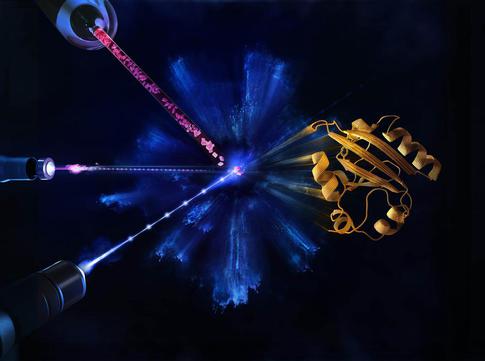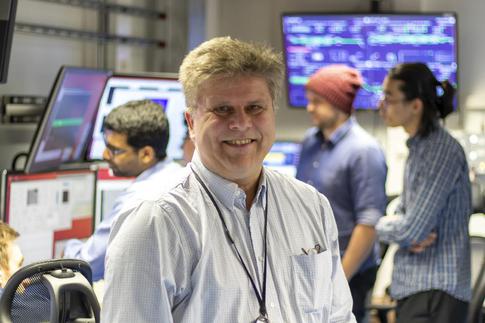XFEL: Interview with user Marius Schmidt
Interview with user Marius Schmidt
Prof. Marius Schmidt from the University of Wisconsin-Milwaukee has participated in half a dozen experiments done at the SPB/SFX experiment station at European XFEL, including the first one with Anton Barty in 2017. Bernd Ebeling spoke with him about his experiences as a user, the potential of XFELs in biomedicine, and about a restless old dog.
Marius, how did you first become involved with XFELs?
I come from the life sciences, biology, and then went into physics, with a PhD in Physics at the TU Munich. In 2007, I became a professor at the University of Wisconsin-Milwaukee. I was very lucky, because the people there were very dedicated to XFEL research. It was really an early XFEL science hotspot! That gave me the opportunity to be involved in numerous beamtimes at LCLS and SACLA, and later at European XFEL.
What are your research interests?
I do time resolved crystallography. I got hooked to this when I worked as a research associate with Keith Moffat in Chicago, who was one of the pioneers in this area. It is very interdisciplinary, including programming, biochemistry and data analysis. For many years I worked with the systems that were available for synchrotron research, which were basically only myoglobin and photoactive yellow protein. Now, at the XFELs, you can do many more.
How exactly did the emergence of XFELs change your field of research?
With macroscopically large crystals you are pretty much limited to cyclic reactions, which you can start multiple times in the same crystals. If you have a non-cyclic reaction, you can only start it once, and then you have to do something –wash away the product and load substrate again, which complicates the experiment dramatically. There are only a few heroes who were able to do this successfully with some proteins. But with the emergence of serial crystallography we can finally investigate non-cyclic reactions. You discard the crystal after it has been hit by the X-rays anyway, but still get enough information.
At SPB, you investigated photoactive yellow protein, or PYP, a well-known model system for cyclic photochemical experiments.
PYP is a beautiful system. A lot is known about it, and therefore it is fantastic for proof-of-principle experiments. But some aspects are still unknown, and we were able to shed light on this here at European XFEL. It will also be interesting to go beyond the femtosecond timescale in the future and look at even faster processes. There is still life in the old dog PYP!
Like this one, many experiments at XFELs are still at the proof-of-principle stage, working with otherwise well-known models. When will you be able to explore what nobody has seen or known before?
 Download [1.7 MB, 8547 x 6380]
Download [1.7 MB, 8547 x 6380]
Artistic visualisation of a serial crystallography experiment. A laser using visible light (centre left) strikes a crystalline protein to initiate a reaction. These crystals are fired into the path of the laser in a jet (top left). After a short time delay the X-ray laser (bottom left) strikes the crystal. The resulting diffraction pattern, recorded before the crystal explodes, can be used to reconstruct the structure of the protein. By repeating this with different time delays between optical and X-ray lasers, a molecular movie can be produced - just like many still images can be pasted together to make a film. Copyright: European XFEL / Blue Clay Studios

Artistic visualisation of a serial crystallography experiment. A laser using visible light (centre left) strikes a crystalline protein to initiate a reaction. These crystals are fired into the path of the laser in a jet (top left). After a short time delay the X-ray laser (bottom left) strikes the crystal. The resulting diffraction pattern, recorded before the crystal explodes, can be used to reconstruct the structure of the protein. By repeating this with different time delays between optical and X-ray lasers, a molecular movie can be produced - just like many still images can be pasted together to make a film. Copyright: European XFEL / Blue Clay Studios
We already are, there were unknown aspects which we investigated. But I can already give you another example: In March we will have a beamtime here, of which you could say that the XFEL starts to save lives. We will look at ß-lactamase, an enzyme that confers antibiotic resistance. Such enzymes are extremely relevant to biomedicine! The reaction will start when the reacting molecule diffuses into the enzyme crystal. Starting a reaction by diffusion has been a dream of scientists for almost half a century. Before XFELs, the crystals had to be very large and diffusion –or the time the reacting molecule needs to enter the enzyme crystal –took way too long. Now, as we were already able to show at LCLS and European XFEL, we can examine much smaller crystals, and the reacting molecule diffuses into the crystals extremely rapidly. We call this method “mix and inject”.
European XFELis still a very young facility. Do you see points where we still have to improve our performance?
Most of the points I could mention in my field are actually already fixed or addressed. For instance, we need faster jets for sample injection, to transport the samples that have been hit out of the area of interaction. And jets that provide better hit rates, to collect our data sets faster. But let me also say that I am super-impressed by the AGIPD detector whose collection rate is unparalleled. I am also impressed by the entire hutch, and you have very impressive beamline support. Maybe the most important point is that now and in the foreseeable future, European XFEL will be the only place where you can work with hard X-rays at high repetition rates. This is the major difference to the other facilities.
What are your own plans for the future?
I am lucky that I don’t really have to think about it. Our beamtimes here at European XFEL and at SACLA have been so successful that I could slow down right now. However, as I said we will come in March with a new mix-and-inject experiment. With this being established, the European XFEL will become a biomedically relevant machine. And I think this should be the number one goal for all of these machines.
What do you expect to happen in the next 10 years?
Structural biology will be done in a time-resolved way. It should become a routine method, for example for highly relevant drug targets. Researchers should be able to send an enzyme and a substrate to an XFEL facility, and then somebody there should be able to do the experiment in half a shift and send the data back.
That would also mean that we will have different users. Others, that are, unlike yourself, not XFEL experts.
That is correct. The only thing these new users should need to know would be how toget micron sized crystals. The rest, like sample handling and data analysis, could either be done by experts at European XFEL, or, in some cases, in a highly automated way. But we will need to support these new users and grow the community! I know people with such biomedical applications who apply all the time but never get beamtime. This I think needs to change. Basic science has to have a clear place at European XFEL, but the applied sciences should have their place as well. And this will probably also be relevant to guaranteeing sustainable funding.

